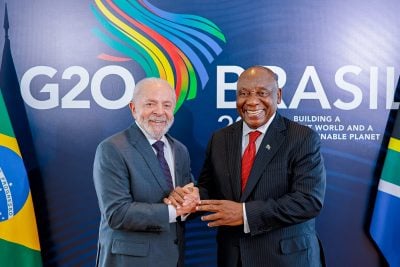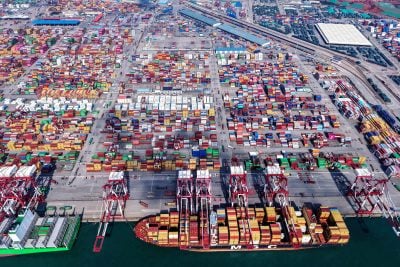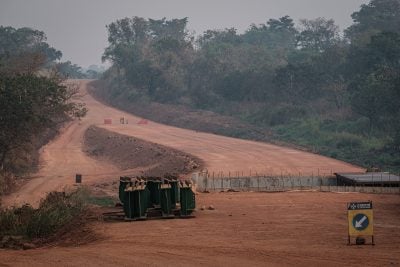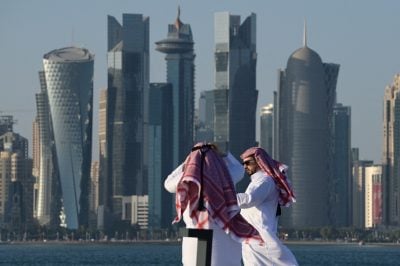With economic growth across Africa set to rise to five percent in 2016, the world’s largest infrastructure company, GE, is looking to invest in new developments. In an exclusive interview with African Business’ associate editor, Tom Nevin, its CEO, Jeff Immelt, explains why African governments should envisage smaller-scale, more agile projects.
Jeff Immelt is an interesting man to interview. Masses of charm and an easy affability is what you experience first, but you quickly become aware of an underlying layer of steel and that tells you what he’s probably like in the boardroom or in a top-level negotiation. The good thing is that he lets you know it early and that helps the conversation along.
It turns out the chief of the world’s biggest infrastructure company wants more first-hand knowledge of Africa as a market and that’s why he was in South Africa. His swing through the continent took in mainly Kenya, Nigeria and South Africa, the region’s biggest economies, if you exclude Egypt. The continent is massively in need of infrastructure of all kinds and he wants to be sure GE is in the right place at the right time.
Kenya is the East and Central Africa regional economic leader. It’s getting the politics right and it is the new continental investment magnet: crime, corruption and other lawlessness is waning rapidly. The signs are all good. Things are happening for Kenya and Immelt wants his company to be there as the investment toboggan starts to gather speed. It’s also a strategic and convenient gateway through which to usher the company’s plans for other countries in the region.
GE is not alone in choosing Kenya as a regional command post. Already big corporate names are ensconced – Nestlé, Heineken, Coca-Cola and Bharti Airtel and others are all there seeking stability, easy access to the region and a skilled workforce.
“We have opened the regional office in Nairobi to serve sub-Saharan Africa because GE has identified ample opportunities to invest in, especially in infrastructure,” says Immelt. “We will have adjustments throughout Africa, and we’ll pay attention to each country with Nairobi as our administrative headquarters, except for South Africa, which will be managed as a separate entity.”
Perhaps because of a low-key profile, GE seems to be lagging in the new race for Africa. However, “We’ve been here for decades,” Immelt points out. “We’re close to an annual $2bn in revenue so we’re as big if not bigger than many of our global competitors in Africa. We want to do better. So it’s not a start-up at all, it’s more of an acceleration. That’s what I would call it.”
GE homes in on infrastructure for Africa
“We’re probably the world’s biggest infrastructure company,” says the GE helmsman. “Healthcare, aviation, locomotives, power generation – we see all those businesses having a good fit here in Africa. From a geographic standpoint it’s hard to plot a 50-country strategy, so we think about East Africa and what an alliance of five countries can mean.” The same applies to South Africa with its tariff-free satellites of Swaziland, Lesotho, Botswana and Namibia market expanders. The Nigerian hub offers similar economic comforts: oil-producing countries Angola, Ghana and Nigeria are clearly big targets. “We think about maybe four big geographic clusters and then maybe five or six industries where we can establish strong positions. So that’s how we think about the region.”
GE isn’t big for small reasons; for one thing it’s a leader in hi-tech solutions for a plethora of industrial applications, so the question has to be asked: Is Africa ready for a company as tech-savvy as GE?
“My view,” says Immelt, “is that we don’t always need new products in Africa. We need solutions that are tailored to what Africa can buy and can afford. The issue is more one of solving problems, financing, servicing projects across the industries.
“We have technical solutions that fit the needs of customers in Africa. South Africa’s Transnet rail company is a good example. It has to be productive and carry freight at a cost-effective rate. Locomotives they purchased from us are 25% more fuel efficient for a start, so it’s not a question of selling them poor products – these are actually great products. But it’s making them fit their context where fuel savings and reliability give value. That’s the way I’d see it here.”
The nuclear issue
South Africa’s on-off nuclear-power facility expansion is a must-ask topic and with speculation in the air about a restart to bidding for new build, could GE be a contender this time around? “We view every nuclear opportunity on a case-by-case basis,” says Immelt, not giving much away. “If someone wants boiling water technology, we’re good at that, if the liability regime is right. We have a global partnership with Hitachi, our products are competitive and we’ll review every bid. From an energy standpoint, we have other opportunities here – wind, coal and other technologies as well.”
There is a movement afoot for African governments to downsize the projects they envisage – instead of a 20,000MW power station that takes forever to plan, bankroll and build, they tend to consider a few smaller ones that are more easily attainable. Is GE happy to cooperate in and even help finance such smaller-scale projects than it is used to in the developed world?
Immelt says he would welcome such a development. “I think governments everywhere, including Africa, make things too complicated,” he observes. “Let’s do the easy things first, I say. Smaller energy projects are almost always better. And as a company we should be nimble enough to fit into those schemes. The notion is absolutely right.”
Africa is a thirsty place. Water is at a premium, and tackling such problems is a GE speciality. How specifically can GE help?
“We have a $2bn plus water business and what we’re best at is industrial water reuse, targeting 100% of water to be reclaimed and reused. We have some great solutions that can really stretch the usage of water. It’s a big need in Africa, as it is in places around the world. We believe this will be a big opportunity.
“We have installed desalinisation plants around the world and they are highly customised 20-year PPAs (power purchase agreements) and very complicated. Industrial water recycling projects can be done quickly and have a high yield over time in terms of the environmental impact.”
The Africa region, like the rest of the world, is in slow recovery in the wake of the series of economic shocks of the past few years. In this climate business performance has slowed down as a result. Have the effects showed up on GE’s order book? “Our business grew pretty substantially last year,” responds Immelt, “and based on orders for the period, I can’t see any reason why we can’t grow by 15% a year for the next few years on the base of a couple of billion dollars. We have to execute well, we’ve got to stay focused on key initiatives but the growth is in that order of magnitude. It’s meaningful.”
Eye-watering revenue numbers
GE’s revenue is so considerable that it’s hard to get to grips with the financial numbers if you’re used to African scales. The continent contributes just over 2% of the company’s revenue, but that’s an eye-watering $2bn and begs the question whether such small percentages are an opportunity or an obstacle.
“Our industrial company’s revenue is about $100bn and the financial services arm contributes another $50bn,” says Immelt. “With Africa at about 2% of our industrial revenue, I think that points to an opportunity. But there’s a different context to consider. Africa for GE is bigger today than China was 10 years ago – and China today for GE is very big. Will Africa go on that same trajectory? Probably not, but sometimes small numbers get big fast. You need a couple of things to happen. You need an ongoing sense of stability and the mineral resource wealth to be reallocated back into infrastructure industrialisation, so you need a stream of investment into infrastructure. You need a growing middle class that values things like healthcare and social security. All will support long-term growth. Sometimes small things get big and you want to be there when that happens.”
Making PPPs work
Immelt is the original champion of market dynamics and believes that the best kind of development happens when the public and private sectors get together, the public sector supplying a secure and trustworthy enabling environment and the private sector arranging the finance, supplying the skills and doing the design and build. Africa seems tailor-made for such an arrangement. The private and public sectors each have what the other needs. But a stubborn and inherent mistrust gets in the way. Is there a future for PPPs (public-private partnerships) in getting together to make the continent work?
“The world I know best is infrastructure, so the examples I’ll quote are based on infrastructure,” says Immelt. “You need long-term value commitment. If you’re going to do a PPP on a hospital or a power plant, someone’s going to have to sign up for a 20-year commitment so you’re going to need politicians who can sign up for that period, or a country in which the contract survives regime changes. I would say that for GE to do a PPP in South Africa without a local South African private sector partner would be insane.”
In his view, PPPs are three-way deals, not two-way deals – invariably complicated with legal and long-term requirements and someone has to take the risk on market movements. “I remember in one of my previous visits there were blackouts,” he recalls. “And one of the issues was that the power utility Eskom couldn’t raise its rates because the government wanted subsidised low-cost electricity. No-one’s going to finance a power plant when you’re forced to charge less than your cost. But PPPs are an important part of the development mix and the advantage of a company like GE is that most of us have been around for 30 years, and it is highly likely that whoever takes our place someday is not going to break the deal, and will live up to whatever arrangement we put in place.
“Companies like ours are long-term players and we like to have PPPs. They’re really hard but they have to be part of the solution. Governments don’t have the money to finance the infrastructure build but there is third-party capital that can solve these problems.
“And there’s plenty of cheap capital around looking for a home. If the US 10-year Treasury is 1.9% and you can finance a 20-year infrastructure project that has a long-term purchase price agreement earning 4% to 6%, that’s a pretty good trade. If you have a big corporate guarantee or a sovereign guarantee, you will find capital for projects like that.”
A company like GE going into a PPP would attract a lot of confidence for the project, from both sides. Immelt agrees and takes the view that his company doesn’t have to be a majority shareholder. “We can hold as little as 10% of the project. Our partners trust our underwriting and our technical capabilities. That’s the way we play – not concentrated but with many PPP bets over the region.
When asked if GE’s contemplating anything of the kind in Africa right now, Immelt’s response is an enthusiastic, “A bunch! From healthcare to railway”, and he expands, “We don’t want to be a railway concessionaire or a hospital operator, but we might have a small equity stake and sell in our equipment. PPPs are essential in Africa. The challenge in Africa isn’t technical, it’s business. We’ll sell the same wind turbine in South Africa as we would in Europe or the US, or a similar version. What’s different in Africa is the way the project is financed, the kind of equity you have to have and things like that.”
Immelt considers GE a good teacher, completing projects and leaving behind people who have learned life-changing skills on the job. “I think that’s a big deal,” he says. “For decades we have worked with our customers to train them around the productive use of our assets, and we are very good at that, maybe as good or better as anyone in the world. When you go country by country where there’s 30% unemployment, you see the massive need for training. One of the things we might look at with partnerships are ways to transfer our technical capability even outside the footprint of our products.”
Asked where GE would most like to be in Africa, both sectorially and geographically, Immelt selects off-grid power generation. “It’s something huge in Africa because so few people here have access to electricity. But that’s also true for developed parts of the world where the grids themselves have been underutilised. So I see a big application for distributed energy whether it’s solar, wind, gas or diesel engines.
“Bringing automation technology and environmental technology to mining is another. We’re seeing some interesting new technical avenues to improve reduced emissions and to improve safety. One of the things we try to do in India that is applicable to Africa is hi-tech healthcare products at lower price points.”
The fact that the CEO of the world’s largest infrastructure company has been spending time in Africa is itself significant. Could this be the start of Africa’s much-needed infrastructure renaissance?
Want to continue reading? Subscribe today.
You've read all your free articles for this month! Subscribe now to enjoy full access to our content.
Digital Monthly
£8.00 / month
Receive full unlimited access to our articles, opinions, podcasts and more.
Digital Yearly
£70.00 / year
Our best value offer - save £26 and gain access to all of our digital content for an entire year!

 Sign in with Google
Sign in with Google 





